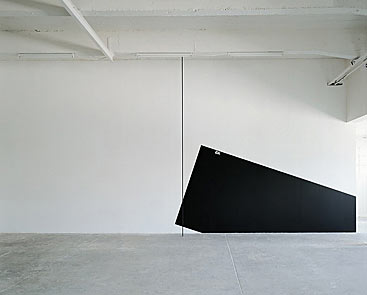
Born in 1940 in New York City, New York (US)
Lives and works in Brussels (BE)

1992
Painted wall, adhesive letters and painted steel pipes
Dimensions variables
Year of Purchase: 1992
Three elements form the vocabulary of this piece: black acrylic covering the visible part of a rectangle made on the wall; a metal tube, also black in colour, extending from floor to ceiling, placed about 4 inches away from the wall; and adhesive vinyl letters forming three words, two in black, one in white. Otherwise put, this is a work which involves wall painting, sculpture and language all at once.
The first thing about this piece is the way it brings in space into play, which we might call its multi-dimensionality. The vertical axes (the metal tube), the horizontal axes (the placing of the word ‘TO’ parallel to the right angle formed by the wall and the floor, where the wall painting ‘disappears’) and the diagonal axes (the sides of the black rectangle and the positioning of the word ‘A’) are all active. What is more, the vectorization of the space of the work is multiple, too. The piece offers a left-to-right itinerary when the viewer reads ‘TO’, but the direction is reversed when the word ‘SA’ is up for reading. The two letters of ‘IF’ propose a third reading axis, perpendicular to the one on which the other two words can be read, from left to right or right to left. But there is more still to all this, because, not content with pluralizing its axes and directions, this piece turns out to be three-dimensional in so far as it mobilizes the wall, as well as the ceiling and, above all, the floor. In so far, too, as the black tube, on the one hand, is itself three-dimensional, but, in addition, determinedly dodges the plane of the wall, by being some 4 inches away from it.
The viewer’s eye is invited to shift vertically, sideways and depth-wise, but his mind is also invited to play the verticality game; this is the second feature of this piece. So not only is the work’s field multi-dimensionalized, but in addition it does not form a focal point, because some of its aspects summon us to leave it alone. First and foremost, the words used are not substantives but conjunctives, waiting for some complement. To open out the game further, two of these articulators are words with many meanings: ‘SA’ can mean comparison, cause, and time; ‘TO’ marks movement, culmination, attribution, goal, and perhaps just a simple particle introducing an infinitive. As for ‘IF’, its many-meaning’s virtuality is not required because, per se, the term denotes this. In this regard, we cannot forget the virtuality which is that of the rectangle, whose missing part the spectator must mentally recreate, just like the data of the experiment he carries out by discovering this work, which enables him to activate the three words proposed. Last of all, what is open and not predetermined is the order in which the spectator will understand this multi-dimensional piece.
Rarely are viewers given the opportunity to undertake the real test of plurality as much as they are with this piece.
Michel Gauthier